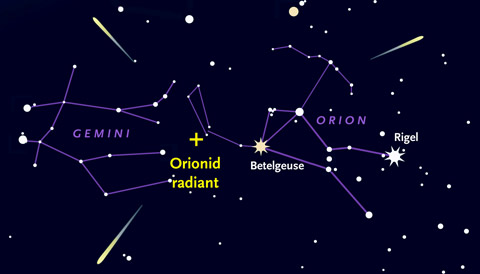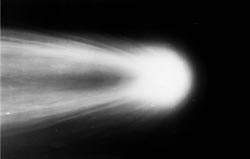The Orionid shower is a long-lasting display of meteors that peaks about October 21st. With moonlight not a factor, an observer under clear dark skies might see an Orionid every 5 minutes in the hours before dawn.
Just about everyone has heard of Halley's Comet. It last cruised through the inner solar system in 1986, and now it's nearing aphelion well beyond Neptune's orbit.
[caption id="attachment_255428896" align="alignright

The Orionid shower is a long-lasting affair that runs from roughly October 17th to 25th and peaks around the morning of the 21st. This shower is actually a complex of several threads of debris that arrive over several days. These radiants (the points in the sky from which the meteors appear to radiate) are grouped near Orion's club, as shown on the accompanying chart.
Since Orion doesn't rise in the east until around midnight, you'll have to stay up at least that late (or get up very early) to see any Halley bits flashing across the sky. For observers around 40° north latitude, the shower's radiants rise high in the eastern sky (at least 45° up) by about 2 a.m. So that's about when the meteor activity is best. Dawn's twilight begins stealing into the east about four hours later.
There's good and bad news concerning this year's Orionid meteor shower. The good news is that it won't have to compete with moonlight, thanks to a thin waning crescent.

The seething nucleus of Halley's Comet, as photographed on May 8, 1910, by the 60-inch telescope at Mount Wilson Observatory in California.
Carnegie Institution of Washington
The bad news, according to the International Meteor Organization, is that we're likely near the low point in a 12-year cycle of activity. The shower boasted up to 70 meteors per hour during 2006 through 2009. This year, however, even under ideal conditions, you'll be lucky to catch 20 meteors per hour.
Like the Eta Aquariids, the Orionids tend to be faint and swift, as they strike our atmosphere at 41 miles (66 km) per second (only November's Leonids come in faster) — and they often leave briefly glowing trains.
Track a year's worth of sunsets and sunrises — and all the celestial highlights that happen in between — with our annual Skygazer's Almanac.
 0
0


Comments
You must be logged in to post a comment.